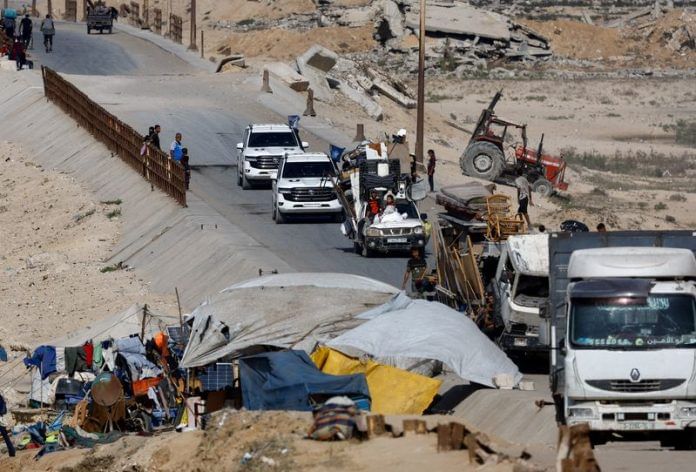(Reuters) -U.S. President Donald Trump says the deal agreed between Israel and Hamas marks the first steps toward a “strong, durable, and everlasting peace” that will end the two-year-old Gaza war.
Yet Wednesday’s agreement reached in the Egyptian resort of Sharm el-Sheikh, a favoured location for Middle East peace conferences over the decades with a patchy record of success, is only an initial phase covering handing over hostages held in Gaza, exchanging them with Palestinian prisoners inside Israel and a partial withdrawal of Israel from the enclave.
Plenty of pitfalls remain after negotiators left for later discussions about some of the thornier issues on which previous initiatives have foundered, such as the full extent of an Israeli withdrawal, the disarmament of Hamas and who and how to guarantee that war will not resume after this phase.
HAVE THE GUNS FALLEN SILENT?
Not yet. Trump demanded Israel halt its bombing when Hamas first indicated partial acceptance for his 20-point plan on Friday. That has not happened. Scores of Palestinians have been killed since then in airstrikes and shelling, particularly in and around Gaza City, the focus of a recent Israeli offensive.
However, the bombardment has been more sporadic since Trump declared a deal had been secured on Wednesday, prompting celebrations in Israel, where families of hostages were jubilant in Tel Aviv’s so-called hostages square, and in Gaza, where people gathered among the ruins even as blasts could be heard.
HOW DOES THIS DIFFER FROM CEASEFIRES THAT COLLAPSED?
While this is a partial deal, a notable difference from previous ceasefire arrangements is that there is no deadline for reaching a full deal. It does not set a deadline of a few weeks, after which hostilities could resume if talks falter.
The jury is still out on whether that makes this deal more durable. There are those among Prime Minister Benjamin Netanyahu’s religious nationalist coalition who are already talking of more war. Finance Minister Bezalel Smotrich, a staunch opponent of any concession to Palestinians, has called for Hamas to be destroyed after the hostages are returned.
But on this occasion, Trump has been far more vocal in his determination to hold feet to the fire on both sides, leaving less room for Israel to relaunch its offensive or Hamas to delay, even if past experience counsels caution over too much optimism.
Trump announced his plan standing next to Netanyahu in Washington last week with what seemed a “take-it-or-leave-it” offer for Hamas. Yet when Hamas gave only a partial acceptance, Trump immediately demanded Israel stop bombing. And as the days ticked by in Sharm el-Sheikh talks, he warned Hamas “all HELL, like no one has ever seen before, will break out” if it did not sign up.
By stamping his authority, Trump may have gone some way to answering the key question of who will guarantee this deal does not collapse at the next hurdle.
SO WHAT HAPPENS NEXT?
The timeline is emerging but still seems fluid.
A ceasefire is expected to come into force once Israel’s cabinet approves the deal at a meeting expected on Thursday. Israel will withdraw to predetermined lines within 24 hours after that. Once the shooting stops, Hamas is set to release hostages within 72 hours, which could possibly be on Monday.
Humanitarian aid to Palestinians should then start to flow. Trump’s plan also calls for an international stabilisation force, which could start taking shape when European ministers and top officials from Arab states meet in Paris on Thursday. They will also discuss issues such as future governance of Gaza, aid, reconstruction and demilitarisation.
Trump is expected to travel to the region in coming days. The White House said he was considering heading there on Friday.
WHAT ARE THE POLITICAL CALCULATIONS FACING HAMAS AND ISRAEL?
Both Israel and Hamas have shown a readiness to respond positively to pressure from Trump and others, but each side faces their own political calculations.
For Netanyahu, agreeing to the plan seems based on a calculation he stay on the right side of the United States, Israel’s vital ally, and win over an Israeli public desperate to see an end to the war, while conceding as little as possible to avoid alienating his religious nationalist coalition partners. The 20-point plan, for example, offers a possible pathway, albeit highly conditional, to a Palestinian state although Netanyahu has said that will never happen.
Hamas has dropped its opposition to any that was only partial because of the risk of war resuming once hostages were handed over. It has also signed up to deal calling for demilitarisation, which it has repeatedly rejected.
Under pressure from Arab states and Turkey, alongside Trump, Hamas may have had little choice but to accept. But it may be calculating Trump’s determination is the best guarantee that war will not resume for now, while the talks in Sharm el-Sheikh have put the militant group at the negotiating table to shape the future for Palestinians even though the deal seeks to sideline it.
(Reporting by Reuters correspondents; Editing by Edmund Blair and Timothy Heritage)
Disclaimer: This report is auto generated from the Reuters news service. ThePrint holds no responsibility for its content.






